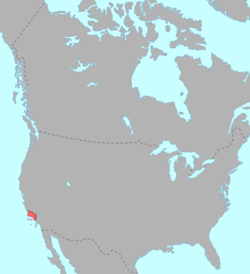Las lenguas chumash es una familia lenguas que fueron habladas en el sur de la costa de California (desde San Luis Obispo hasta Malibú), en las regiones vecinas (Valle de San Joaquín) y en tres islas cercanas (San Miguel, Santa Rosa y Santa Cruz).
Esta familia está actualmente extinta. El último hablante de una lengua chusmash fue Mary Yee, quien murió en 1965 y hablaba barbareño.
Clasificación
Clasificación interna
Esta familia consta de 6 lenguas:
I. Chumash del norte
- 1. Obispeño (†)
II. Chumash del sur
- a. Chumash insular
- 2. Isleño (†)
- b. Chumash central
Relaciones con otras lenguas
Roland Dixon y Alfred L. Kroeber sugirieron que las lenguas Chumash podían estar relacionadas con el geográficamente cercano idioma salinero, y llamaron a esta unidad filogenética propuesta iskomano.[1] Edward Sapir consideró razonable dicho parentesco e incluyó el iskomano en su clasificación de las lenguas hokanas.[2] Más recientemente se comprobó que el salinero y las lenguas Chumash no comparten léxico más allá de algunos préstamos, que las lenguas Chumash probablemente tomaron del salinero.[3] Como resultado, la inclusión del Chumash en el grupo hokano ahora se considera menos probable por parte de los especialistas, y el consenso más extendido es que el Chumash es una pequeña familia aislada.[4]
Descripción lingüística
Fonología
Las lenguas chumash son conocidas por su armonía consonántica (armonía de sibilantes regresiva).
Comparación léxica
Los numerales en diferentes lenguas chumash son:[5][6]
GLOSA Obispeño Santa Cruz Barbareño PROTO-
CHUMASH'1' tsuxumu ismala paka * '2' ecin isxum ickomo *i-c͡çumu '3' mica masex masex *mɨsex '4' paksi ckumu ckumu *-c͡çumu '5' tiyewi sit-isma yit-paka *t͡ʃit+1 '6' ksua-sya sit-isxum yit-ckomo *t͡ʃit-c͡çumu '7' kcua-mice sit-masex yit-masex *t͡ʃit-mɨsex '8' ckomo malawa malawa * '9' cumo-tcimaxe spa tspa * '10' tuyimili ka-ckumu kel-ckomo *kal-c͡çumu
Referencias
- ↑ Dixon and Kroeber 1913
- ↑ Sapir 1917
- ↑ Klar 1977
- ↑ Mithun 1999:390
- ↑ Dixon, R. B., & Kroeber, A. L. (1907). Numeral systems of the languages of California. American Anthropologist, 9(4), 663-690.
- ↑ Klar, Kathryn A. 1977. Topics in Historical Chumash Grammar. Doctoral dissertation, University of California at Berkeley.
Bibliografía
- Applegate, Richard. (1972). Ineseño Chumash Grammar. (Doctoral dissertation, University of California, Berkeley).
- Campbell, Lyle. (1997). American Indian languages: The historical linguistics of Native America. New York: Oxford University Press. ISBN 0-19-509427-1.
- Dixon, Roland R.; & Kroeber, Alfred L. (1913). New Linguistic Families in California. American Anthropologist 15:647-655.
- Goddard, Ives (Ed.). (1996). Languages. Handbook of North American Indians (W. C. Sturtevant, General Ed.) (Vol. 17). Washington, D. C.: Smithsonian Institution. ISBN 0-16-048774-9.
- Klar, Kathryn. (1977). Topics in historical Chumash grammar. (Doctoral dissertation, University of California, Berkeley).
- Mithun, Marianne. (1999). The languages of Native North America. Cambridge: Cambridge University Press. ISBN 0-521-23228-7 (hbk); ISBN 0-521-29875-X.
- Grant, Campbell. (1978). Chumash:Introduction. In California Handbook of North American Indians (William C. Sturtevant, General Ed.) Vol. 8 (Robert F. Heizer, Volume Ed.). Washington, D. C.: Smithsonian Institution.
- Sapir, Edward. (1917). The Position of Yana in the Hokan Stock. University of California Publications in American Archaeology and ethnology 13:1–34. Berkeley: University of California.
- Wash, Suzanne. (1995). Productive Reduplication in Barbareño Chumash. (Master's thesis, University of California, Santa Bárbara; 210 + x pp.)
- Wash, Suzanne. (2001). Adverbial Clauses in Barbareño Chumash Narrative Discourse. (Doctoral dissertation, University of California, Santa Bárbara; 569 + xxii pp.)

